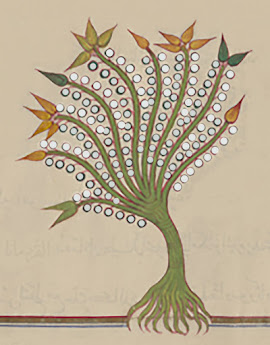Welcome to the April A to Z Blog Challenge! My theme this year is the Botany of the Realms of Imagination, in which I share a selection of the magical plants of folklore, fairy tale, and fantasy. You can find out about the A to Z Challenge here.
Following straight on from the last post, we’ll begin today with the tree of Life. This is a general term, rather than a specific species, and cultures around the world and through history have had their own different versions. Nevertheless, it’s a fairly universal motif in folklore and mythology. Sometimes it’s conflated with the tree of Knowledge (flashback to K), and sometimes it’s conflated with the World Tree (foreshadowing), but generally speaking its most fundamental trait is that it represents the connections between living things and all of creation, and that it has properties of immortality and/or fertility. We’ve already seen five plants that may be considered trees of Life: the Fusang tree at F, Hera’s Golden apples at G, the Huluppu tree and the Haoma plant at H, and the Jo Mu tree at J. There will be more to come, as well, so I won’t mention any other specifics today. Trees of Life are a very popular motif in art - indeed, I’ve done it myself! They can be depicted naturalistically or very stylized, so I’ve selected a sampling just to give you a very small taste of some of the diversity. (Mine is the first.)
Love-in-idleness is the flower that Oberon, king of the fairies, describes to Puck in Shakespeare’s play “A Midsummer Night’s Dream.” Oberon explains that when the plant was accidentally hit by one of Cupid’s arrows, it gained the magical power to make a man or woman madly dote upon the next live creature that they see. This is the flower that knavish Puck then uses to drive the plot of the play, with people falling in and out of love with each other all over the forest.
Leaves of Pearls is found in an Iranian folktale that begins (flashback to Gul-e-Bakavali) with princes on a quest to find the magical plant that will cure their father’s blindness. In fact, the parallels between the two stories are so close that they could be considered variants, and there are a
number of other variants of the Leaves of Pearl story, as well. In one there’s a bird that sings flowers into existence, which is a lovely image. In another the brothers seek Leaves from the Tutia Tree, in another there’s a magical Zay Tree, and in yet another it’s a Magpie Tree. This might lead one to believe that the world is actually quite full of plants and birds that cure blindness, as well as treacherous brothers, and beautiful fairy princesses who think thieves are super hot. However, I have never experienced any of these things at first hand, so I am not really qualified to comment.
The moral of L is that many of the medicines and drugs considered by the World Health Organization to be most basic and essential are derived from plants, so there really could be some that might help cure blindness or all manner of other ills. This is just one more huge reason we need to stop the destruction of rainforests and other natural reserves, where plants with practically magical powers may yet be growing undiscovered.
Gardening tip of the day: if you wake up one morning madly in love with someone (or something) completely new and unprecedented, try scrubbing out your eyes thoroughly. After all, if magical plants cause love, and love is blind, and magical plants cure blindness… it’s hard to know how to get out of that cycle.
But seriously, if you woke up from a nap and discovered that someone had stolen your greatest treasure, would you want to marry the thief? (There’s no accounting for the taste of fairies. Or perhaps, although it isn’t mentioned in the stories, the prince uses some variant of love-in-idleness on the sleeping princess. What do you think?)
[Pictures: Tree of Life, rubber block print by AEGNydam, 2005 (Image from my web site NydamPrints.com);
Tree of Life palampore, painted resist and dye on cotton, India, first quarter of the 18th century (Image from Met Museum);
The Tree of Life, drawing by G. Howell-Baker from Penholm, 1901 (Image from Cincinnati & Hamilton County Public Library);
Tree of Life, relief from Taq-e Bostan, c. 4th century CE (Image from Wikimedia Commons); Tree of Life, wall painting in Shaki Khan palace, Azerbaijan National Art Museum, 1797 (Image from Wikimedia Commons);
Albero della Vita, sculpture and light show designed by Marco Balich and Studio Giò Forma for Italia Expo Milan 2015 (Image from Wikimedia Commons); Árbol de la Vida, scupture by Alfonso Soteno and Oscar Soteno, c. 1990 (Image from Wikimedia Commons); L’Arbre de Vie, Stoclet Frieze, painting by Gustav Klimt, 1909 (Image from Wikimedia Commons);
Tree of Life, relief from the Palace of Sargon II at Dur Sharrukin, 716-713 BCE (Image from Louvre);
Love-in-Idleness (aka viola), wood block print from Florum et coronarium odoratarumque by Rembert Dodoens, 1568 (Image from Biodiversity Heritage Library);
Leaves of Pearls (adapted from cardamom), illumination from Arabic translation of De materia medica, c. 1889 (Image from New York Public Library).]









































